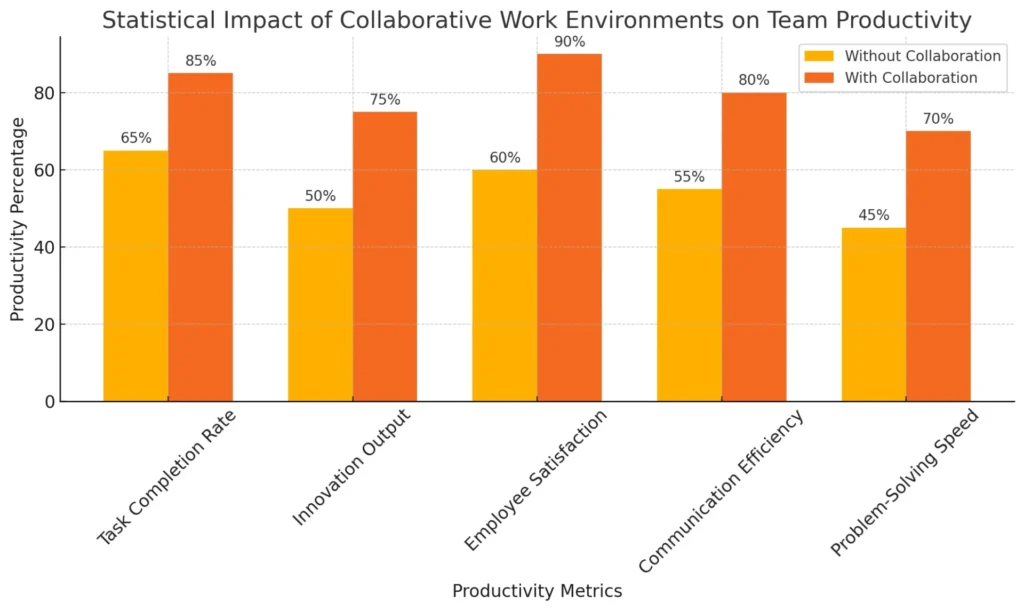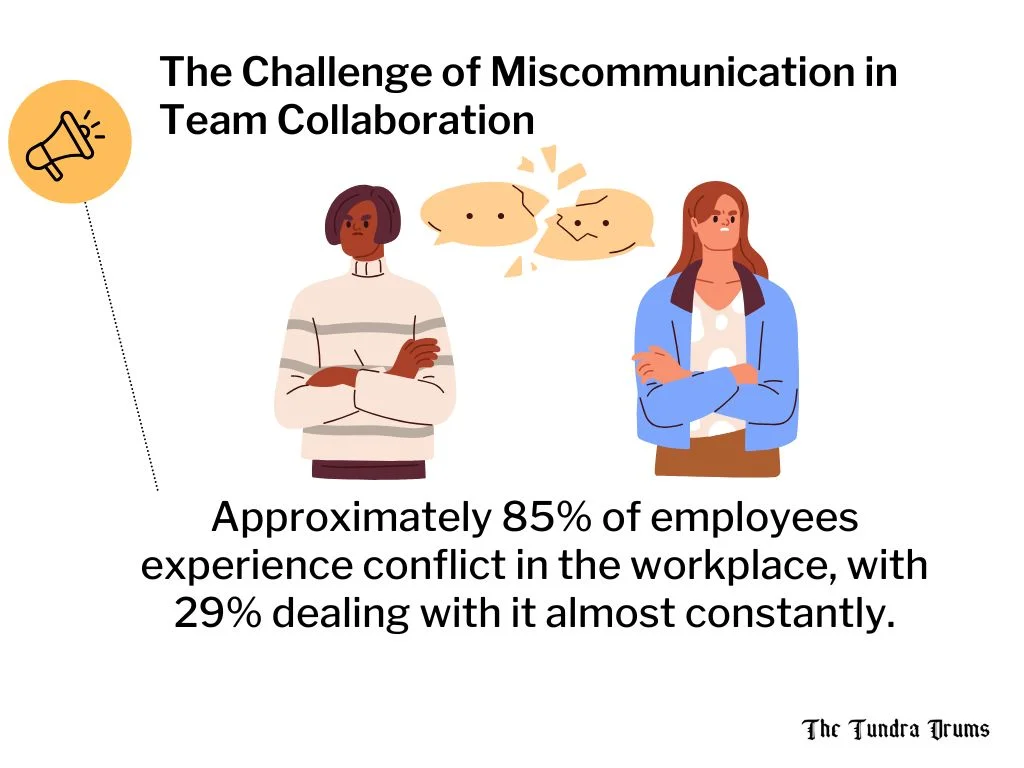A collaborative work environment (CWE) is defined as a workplace culture that emphasizes teamwork, open communication, and collective problem-solving among employees.
In such settings, team members coordinate their efforts in creating a collaborative work environment to achieve shared objectives, leveraging each other’s strengths and fostering a culture of mutual support. This approach is increasingly vital in modern workplaces, where the complexity of tasks and the need for innovation demand a high level of cooperation among diverse teams.
The importance of collaboration cannot be overstated; studies indicate that 75% of employees consider teamwork essential for success in their roles.
As organizations strive to stay competitive in a fast-paced business landscape, fostering collaboration has become a strategic priority. This write-up will explore several key benefits of a collaborative team environment, including enhanced productivity, creativity, and employee engagement.
Statistical Impact of Collaborative Work Environments on Team Productivity

8 Benefits Of A Collaborative Work Environment For Team Productivity
1- Enhanced Communication in the Workplace
Effective communication is a critical component of a successful workplace, directly influencing employee retention and overall productivity. According to the Institute for Corporate Productivity, organizations with effective communication experience 50% lower turnover rates. This statistic underscores the importance of fostering a culture of open dialogue and trust among team members.
2- Increased Innovation Through Collaboration
Collaboration plays a pivotal role in driving innovation within organizations. According to a study by PwC, 86% of executives attribute workplace failures to a lack of collaboration. This statistic highlights the necessity of fostering a collaborative culture to harness creativity and develop innovative solutions.
Examples of Innovative Solutions Arising from Collaborative Efforts
Numerous successful collaborative projects illustrate how teamwork can lead to groundbreaking innovations:
- Google’s Project Loon: This initiative aimed to provide internet access to remote areas using high-altitude balloons. Working in a collaborative team environment with various organizations, Google was able to develop a unique solution that addresses connectivity issues in underserved regions.
- The Human Genome Project: This monumental scientific endeavor involved scientists from around the globe working together to map all human genes. The collaborative nature of this project led to significant advancements in genetics and medicine, showcasing the power of shared knowledge and resources.
- Wikipedia: As one of the most extensive knowledge repositories on the internet, Wikipedia exemplifies collaborative innovation by allowing users worldwide to contribute content. This model has resulted in a continuously updated and reliable source of information.
- OpenAI: This initiative focuses on developing artificial intelligence technologies that prioritize safety and benefit humanity as a whole. The collaboration among researchers and engineers has led to significant advancements in AI capabilities.
- LEGO Ideas: This platform invites LEGO fans to submit their designs for new sets, which are then voted on by the community. The most popular designs are produced as official sets, demonstrating how customer collaboration can lead to innovative product offerings
3- Improved Problem-Solving Through Collaboration
Collaboration is a powerful tool for enhancing problem-solving capabilities within teams. Research from MIT indicates that teams engaging in collaborative problem-solving can increase effectiveness by 20-25%. This improvement stems from the ability to combine diverse strengths and skills, leading to more effective solutions for complex challenges.
4- Higher Employee Engagement
Higher employee engagement has a significant impact on organizational success, as evidenced by a 21% increase in profitability for companies with highly engaged employees, according to Gallup.
When employees feel valued and included, their motivation naturally increases, fostering a sense of belonging and commitment to their roles. A cooperative work environment adds a sense of inclusion and encourages them to go beyond their basic duties, actively contributing to innovative ideas, problem-solving, and collaborative efforts.
Engaged employees are more likely to take ownership of their work, resulting in higher productivity, improved performance, and overall organizational growth. This positive cycle strengthens both individual satisfaction and company outcomes, emphasizing the power of an inclusive workplace culture.
5- Streamlined Processes
Streamlined processes are crucial for enhancing productivity, with McKinsey & Company reporting that connected organizations can improve productivity by up to 25%. By reducing duplication of effort through coordinated tasks, teams can focus on their core responsibilities without wasting time on redundant work.
Clear processes and well-defined workflows are essential for fostering collaboration, as they provide clarity on roles, expectations, and task ownership.
This structure minimizes confusion, ensures accountability, and promotes effective communication, allowing employees to work more efficiently and achieve better results collectively. The synergy created by streamlined processes boosts both individual and organizational success.
6- Stronger Team Dynamics
Stronger team dynamics are essential for organizational effectiveness, with research from Google demonstrating that teams with strong psychological safety are more effective.
Building camaraderie and fostering mutual support among team members creates a work environment where individuals feel comfortable sharing ideas, taking risks, and offering constructive feedback without fear of criticism.
This foundation of trust and respect enhances collaboration, encourages creativity, and empowers individuals to perform at their best. Effective team bonding also has a positive impact on morale and job satisfaction, as employees develop meaningful relationships, feel valued, and experience a deeper connection to their shared goals. This dynamic drives motivation, productivity, and overall team success.
7- Flexibility and Adaptability
Flexibility and adaptability are critical traits for organizational success, and companies with high levels of collaboration are five times more likely to be agile, according to the Harvard Business Review. When teams collaborate effectively, they are better equipped to respond quickly to changes and challenges, leveraging diverse perspectives to find innovative solutions.
Collaboration fosters a culture of adaptability by encouraging open communication, knowledge sharing, and collective problem-solving. This dynamic environment enables employees to pivot quickly, embrace change, and work together to overcome obstacles, ultimately driving the organization’s ability to thrive in an ever-evolving business world.
8- Development of Soft Skills
The development of soft skills, such as communication, teamwork, and problem-solving, is crucial for career advancement. These skills enable individuals to effectively navigate workplace challenges, build strong professional relationships, and lead projects to success.
Collaboration plays a vital role in honing these abilities, as working with diverse teams exposes individuals to various perspectives, enhancing their capacity to understand different viewpoints and adapt accordingly.
Engaging in group tasks, brainstorming sessions, and conflict resolution offers valuable learning experiences that strengthen communication and interpersonal skills. This continuous exposure not only boosts individual competence but also prepares professionals to excel in leadership roles and complex situations.
Challenges of Collaboration and How to Overcome Them

Miscommunication and Conflict Resolution Strategies
Collaboration often faces the challenge of miscommunication, leading to misunderstandings, unmet expectations, and even conflicts. Miscommunication can occur due to differences in language, cultural norms, or varying interpretations of tasks and goals.
Strategies to overcome this challenge:
- Establish clear communication protocols: Use structured communication channels like regular meetings, emails, or chat platforms to ensure everyone is on the same page.
- Foster an open communication culture: Encourage team members to express their thoughts, ask questions, and seek clarifications without fear of judgment.
- Utilize active listening skills: Ensure all team members practice active listening, reflecting on what is being said before responding.
- Conflict resolution training: Equip team members with skills to identify and resolve conflicts constructively by focusing on the issue at hand and maintaining mutual respect.
Balancing Individual and Team Goals
When collaborating, striking a balance between individual goals and team objectives can be challenging. Individuals may prioritize their personal career ambitions or tasks, potentially conflicting with collective outcomes.
Strategies to overcome this challenge:
- Align goals through a shared vision: Clearly communicate the overall objectives and the value each team member brings to achieving them.
- Set measurable goals for both individuals and the team: Create objectives that contribute to both personal development and team success, with regular progress assessments.
- Reward both individual and team achievements: Recognize and celebrate individual contributions alongside team milestones to maintain motivation and cohesion.
Addressing Collaboration Overload
Collaboration overload happens when team members are involved in too many collaborative activities, resulting in burnout, reduced productivity, and inefficiency. This can stem from excessive meetings, redundant communications, or unclear roles and responsibilities.
Strategies to overcome this challenge:
- Prioritize and limit meetings: Only hold meetings when necessary, with clear agendas and defined outcomes. Utilize asynchronous communication tools for updates when possible.
- Clarify roles and responsibilities: Clearly define what each member contributes to minimize overlaps and maximize productivity.
- Empower autonomy: Encourage decision-making autonomy for tasks that do not require constant team input to reduce dependency on group approval and streamline workflow.
- Leverage collaborative tools smartly: Use project management tools to streamline workflows and reduce unnecessary back-and-forth communication, thereby freeing up time for focused work.
FAQs
How does collaboration boost team productivity?
Collaboration fosters open communication, diverse perspectives, and teamwork, leading to more innovative solutions, faster problem-solving, and increased efficiency.
What tools can enhance workplace collaboration?
Tools like Slack, Microsoft Teams, Zoom, Asana, and Trello streamline communication, task management, and collaboration, enhancing overall productivity.
What are common barriers to collaboration and how can they be overcome?
Common barriers include miscommunication, unclear roles, and resistance to change. Overcome these with clear communication, role clarity, and fostering an open culture.
How can leadership promote a collaborative work environment?
Leaders can promote collaboration by encouraging teamwork, providing the right tools, recognizing contributions, and fostering a culture of trust and openness.











